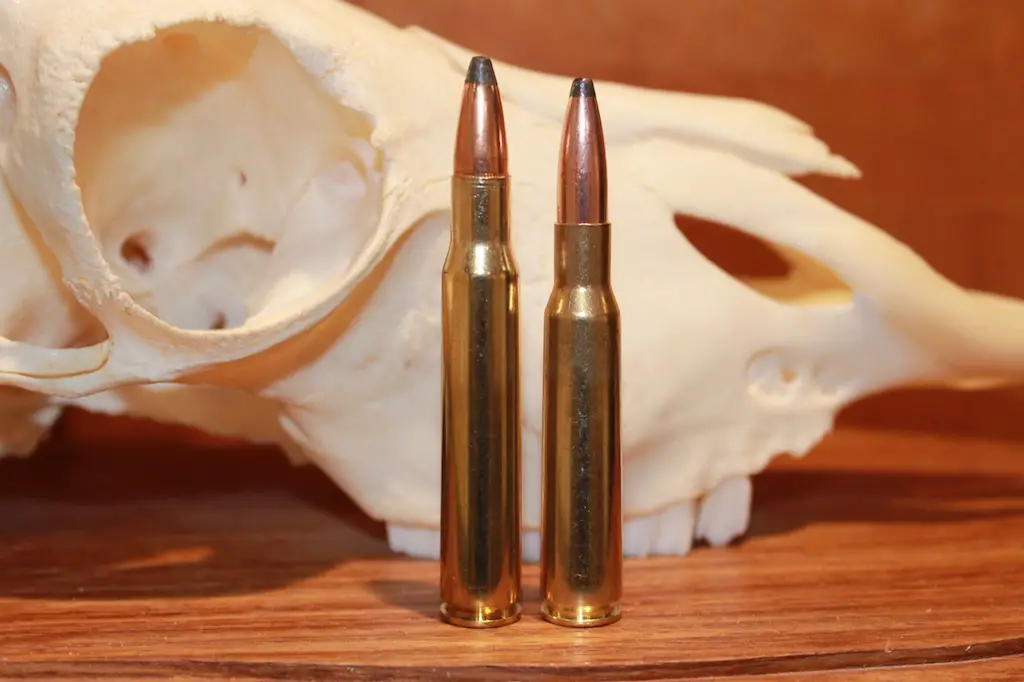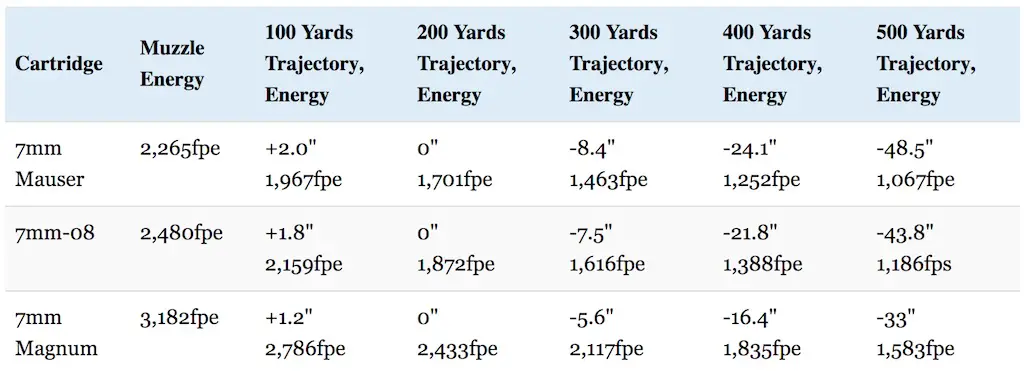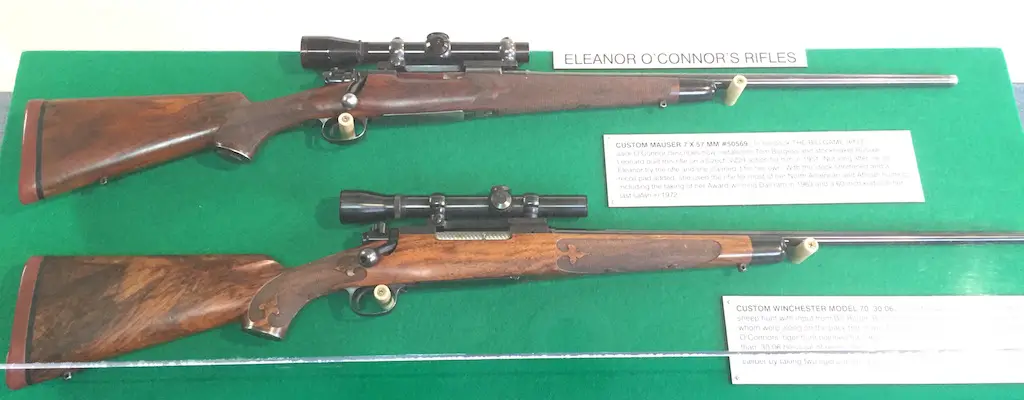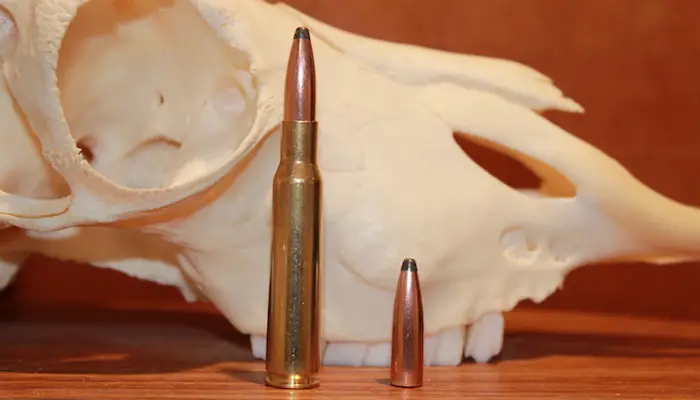The world changed forever when the 7mm Mauser came onto the scene in the 1890s.
Few people have had as big of an impact on the shooting and hunting worlds as the legendary German gun designer Paul Mauser. Though far from his only accomplishments, his work in developing the 7mm Mauser cartridge and the Mauser rifles that fired it may be the most important part of his legacy. Here’s the story of the remarkable 7mm Mauser cartridge.
Note: some of the links below are affiliate links. This means I will earn a small commission (at no extra cost to you) if you make a purchase. This helps support the blog and allows me to continue to create free content that’s useful to hunters like yourself. Thanks for your support.
Additionally, I recorded an entire podcast episode on this exact subject. If you’d rather listen than read, click the appropriate link below to listen to this episode on your preferred podcasting service.
7x57mm Mauser Podcast
Apple | Google | iHeart | Pandora | Spotify
History Of The 7mm Mauser
Also known as the 7x57mm Mauser, the 7mm Spanish Mauser, and the .275 Rigby, the 7mm Mauser was one of the first cartridges designed from the outset to use smokeless powder. This gave it impressive ballistics compared to other cartridges of the day. Designed for the Spanish Army in the 1890s (which is why it’s sometimes referred to as the 7mm Spanish Mauser), the original 7mm Mauser military ammunition fired a 173gr bullet at 2,300 feet per second (about 2,000 foot pounds of energy).
This load was very accurate, had a relatively flat trajectory, and did it all with a modest amount of recoil. Those 173gr bullets were also quite long and had a high sectional density of .310. For that reason, they tended to penetrate very well.
Along with these attributes, the 7mm Mauser was first mass produced in the Model 1892 and 1893 Mauser bolt-action rifles, which were themselves far more advanced than comparable rifles of that time period. Featuring the revolutionary non-rotating Mauser extractor and designed to accept 5 round stripper clips to facilitate fast reloading, the Mauser 1892 and 1893 were accurate, reliable, and easy to maintain.
These are all ideal attributes for a military rifle and Soldiers equipped with these rifles could accurately engage targets at greater ranges and maintain a higher rate of fire for longer periods of time than other military rifles of the late 1800s.

Mauser-equipped Boers taught the British Army a hard-earned lesson on the effectiveness of the 7x57mm cartridge and the Mauser rifle during the Boer War. Likewise, the American Army had a similar experience when a small number of Spanish Soldiers using Mauser rifles inflicted severe casualties on a much larger American force equipped with inferior Krag–Jørgensen and Trapdoor Springfield rifles at the Battle of San Juan Hill.
Indeed, the American Army was so impressed with the performance of the Mauser rifle and cartridge that they developed the 1903 Springfield rifle and .30-03 Springfield (which later evolved into the .30-06) a few years later.
For these reasons, it should come as no surprise that the 7mm Mauser developed a reputation as an outstanding military cartridge. Additionally, the same attributes that made the 7x57mm cartridge and Mauser rifle so popular with the military also made it appealing as a sporting cartridge and it soon became a favorite of hunters all over the world.
7mm Mauser Ammo
While the 7mm Mauser was always more popular in Europe and Africa than in the United States, it still has enough of a following that it’s not difficult to find factory loaded 7x57mm Mauser ammunition at most gun stores all over the world. For instance, Federal, Hornady, Norma, Nosler, Prvi Partizan, Remington, Sellier & Bellot, and Winchester all manufacture at least one 7mm Mauser load. 140gr bullets are the most popular these days, but 139gr, 145gr, 173gr, and 175gr bullets aren’t uncommon either.
Due to advances in propellents, modern factory-loaded 7mm Mauser ammo has slightly improved ballistics compared to the original loads from the 1890s. For instance, Federal advertises a muzzle velocity of 2,390 feet per second for their 7x57mm 175gr Power Shok ammunition.
Additionally, Nosler loads their 140gr Accubonds to an advertised velocity of 2,700fps, which is a great flat shooting and hard hitting load. For those that want a little more velocity, Hornady’s Superformance ammo for the 7x57mm Mauser pushes a 139gr bullet at 2,760fps.
All these different variants of 7mm Mauser ammo have a relatively flat trajectory (more or less comparable to the .308 Winchester or .30-06 Springfield), making them suitable for shots out to 300-400 yards or so (perhaps further) in the right hands. At the same time, the 7mm Mauser does all of that with a very mild recoil. Indeed, since it combines a flat trajectory without much kick, the 7mm Mauser is a great hunting cartridge for small framed or otherwise recoil sensitive shooters.
BUY SOME GOOD 7mm MAUSER AMMO HERE
BUY SOME MORE QUALITY 7mm MAUSER AMMO HERE
Due in part to the popularity of cartridges like the 7mm Remington Magnum, the .280 Ackley Improved, and the 7mm-08 Remington, there are plenty of high quality 7mm bullets (.284″) in production. So, hand-loaders should not have difficulty finding a bullet they like. Almost every premium bullet currently on the market (like the Barnes Triple Shock, Hornady GMX, Nosler AccuBond, and Nosler Partition) is available in 7mm.
A word of caution for reloading the 7mm Mauser though: the 7mm Remington Magnum originally got something of a bad reputation for poor penetration because the original 7mm Magnum loads fired bullets designed for the 7mm Mauser at a significantly higher velocity than what those bullets could withstand. These high impact velocities caused some of those bullets to expand much too quickly on large, tough animals (like elk) at the expense of penetration.
The development of better quality bullets has largely solved that problem and helped rehabilitate the reputation of the 7mm Magnum. However, the opposite is sometimes true for certain types of 7mm bullets: if they are designed to withstand the high impact velocities sometimes encountered with the 7mm Magnum, they may not expand fast enough for good terminal performance when fired at the slower velocity of the 7mm Mauser.
The good news is that bullets these days are much better than they were even 20-30 years ago, and you probably won’t have any issues with high quality bullets. Even so, if you’re planning on hand-loading for the 7mm Mauser, do detailed research on the specific bullets you’re planning on using and verify that they will shoot accurately and that their terminal performance is up to your expectations before you take them hunting.
7mm Mauser vs 7mm-08 vs 7mm Magnum
Speaking of the 7mm-08 Remington and the 7mm Remington Magnum, here is a brief description on how the 7mm Mauser compares to those other 7mm cartridges.
First off, though they have similar names, the cartridges are not interchangeable. Do not attempt to fire one cartridge in a rifle chambered for another (like a 7mm-08 in a 7mm Mauser)
The 7mm-08 and 7mm Mauser have almost identical ballistics on paper. Both cartridges are also known for their accuracy and mild recoil. The big advantage the 7mm-08 has over the 7mm Mauser is that it’s a slightly shorter cartridge (with an overall length of 71mm compared to 78mm for the 7mm Mauser) and therefore packs the performance of the 7mm Mauser into a smaller package. Since it’s so much shorter, the 7mm-08 fits in a short-action rifle while the 7mm Mauser requires a long-action rifle.
The 7mm Remington Magnum has a significantly longer case (83.5mm) and shoots the same size bullet at a much higher velocity and with a correspondingly flatter trajectory. On the other hand, it also has more recoil and muzzle blast than the other two cartridges. Additionally, when hunting game at shorter ranges, those high velocity bullets generate a lot more blood shot meat on thin skinned game like whitetail deer.
The differences between the 7mm Mauser, the 7mm-08, and the 7mm Magnum are most apparent in the table below comparing Nosler’s Trophy Grade 140gr AccuBond ammunition for all three cartridges. As you can see, while the 7mm Mauser and 7mm-08 are no slouches, the 7mm Magnum is clearly the better choice for longer range shots.

All that being said, the difference between the three cartridges (7mm Mauser vs 7mm-08 vs 7mm Magnum) is not as great as some people make it out to be. The cartridges are roughly comparable in terms of the size bullets they shoot and the size game they are suitable for hunting. The only real differences between them are the slight variations in velocity, kinetic energy, and trajectory (where the 7mm Magnum has a the advantage) and recoil (where the 7mm Mauser and 7mm-08 have the edge).
For the vast majority of deer and elk hunting situations at moderate range, the three cartridges perform about the same. If you use a good quality bullet and place your shot appropriately, the animal will never know the difference regardless of which cartridge you’re using.
7mm Mauser Rifles
Since the 7mm Mauser didn’t catch on in the United States like it did in Europe, Asia, and Africa, American gun manufacturers never made large numbers of rifles chambered in the cartridge. Among other models, American companies produced small numbers of Remington Rolling Block, Remington Model 700, Winchester Model 70, and Ruger Number 1 rifles chambered in 7x57mm Mauser over the years.
Not surprisingly, Mauser probably made more rifles chambered in 7x57mm than any other company. It’s still possible to find Mauser Model 1893, Model 1895, and derivatives of the Model 1898 rifles chambered in 7x57mm Mauser in good condition and for a reasonable price. Mauser also made a large number of commercial rifles chambered in 7mm Mauser specifically designed for sporting use and the company also continues to manufacture the M 98 Standard rifle in 7x57mm Mauser.
John Rigby and Company produced a number of rifles chambered in .275 Rigby (which is what the British called the 7mm Mauser) for British citizens hunting all over the globe. Rigby still makes a couple models available in .275 Rigby and occasionally a used rifle will turn up for sale. Those rifles normally don’t come cheap though.
BUY A NICE 7mm MAUSER RIFLE HERE
The Czech firearms manufacturer CZ also has a long history of producing rifles chambered in 7mm Mauser and there are plenty of CZ rifles chambered in that cartridge out in circulation. No less an authority on firearms than Jack O’Connor obtained a custom Czech VZ24 rifle chambered in 7x57mm Mauser for his wife Eleanor. She used it on countless hunting trips all over the world with great success and it’s currently on display at the Jack O’Connor Museum in Lewiston, Idaho along with his prized Winchester Model 70 in .270 Winchester.
In his book The Big Game Rifle, Jack O’Connor describes how metalsmith Tom Burgess and stock maker Russell Leonard built this rifle on a Czech VZ24 action for him in 1951. Not long after, he let Elanor try the rifle and she claimed it for her own. With the stock shortened and a recoil pad added, she used the rifle for most of her North American and African hunting, including the taking of her Award-winning Dall ram in 1963 and a 60″ kudu on her last safari in 1972.

Hunting With The 7mm Mauser
The 7mm Mauser is a great cartridge for hunting medium sized North American game like whitetail deer, feral hogs, javelina, pronghorn, black bear, elk, javelina, mountain lion, caribou, mule deer, bighorn sheep, and mountain goat. The same goes for red stag and roe deer in Europe and New Zealand as well as most species of African plains game like impala, zebra, wildebeest, gemsbok, waterbuck, and kudu.
Though it’s a little on the light side for extremely large animals like eland, American Bison, brown/grizzly bear, and moose, the 7mm Mauser is capable of ethically taking any of these animals under the right conditions.
In that same vein, Jim Corbett detailed multiple accounts of using his .275 Rigby to take man-eating tigers and leopards in India in his book The Man Eaters of Kumaon. Settlers in Africa during the late 1800s and early 1900s also killed untold numbers of thick-skinned dangerous game like buffalo and hippopotamus with the 7mm Mauser. Finally, no discussion of hunting with the 7mm Mauser is complete without mentioning the fact that Karamojo Bell famously killed hundreds of elephants with his .275 Rigby.
While I absolutely do not recommend using the 7mm Mauser for hunting any species of dangerous game (especially thick-skinned dangerous game), these stories are good examples of how the 7mm Mauser is one of those cartridges (like the 9.3x62mm Mauser and the 6.5 Swede) that really “punches above it’s weight.”
Why is that the case?
First, many 7x57mm Mauser loads (especially 173gr full metal jacket military ammunition) use long bullets that have a high sectional density and penetrate very well.
Second, the 7mm Mauser is easy for most people to shoot accurately and place their shots on an animal precisely.
For these reasons, a cool headed marksman that knew exactly where to shoot an animal could use the 7mm Mauser to take game far larger and tougher than you would expect if you just looked at the ballistics of the cartridge on paper. 7mm bullets (especially the non-expanding ones) don’t make nearly as big of a wound channel as .375, .416, or .458 bullets, but if they are placed appropriately, heavy 7mm bullets have very good odds of penetrating through even the thickest muscle and bones to hit the vitals of an animal.
This obviously leaves very little room for error. It’s also true that few hunters have the knowledge of animal anatomy or marksmanship skills necessary to consistently hit exactly the right spot to quickly, safely, and ethically take dangerous game while using an undersized cartridge for the job like the 7mm Mauser.
For those reasons, using the 7mm Mauser on dangerous game is illegal in many African countries and is ill-advised no matter where you’re hunting.
Don’t let that diminish the capabilities of the 7mm Mauser for hunting though. That cartridge has a well deserved reputation for being a wonderful choice for hunting a wide variety of big game because it just works so darn well.
In many ways the 7mm Mauser is something of a “Goldilocks” hunting cartridge: it’s flat shooting and hits hard enough to ethically take most species of big game at reasonable ranges, but it shoots at a moderate velocity so tooth rattling recoil and the loss of large amounts of blood shot meat are not a concern.
While many modern cartridges surpass the capabilities of the 7mm Mauser on paper, don’t get too wrapped up with that stuff. The 7x57mm Mauser may no longer be top dog like it was in the 1890s, but it’s still an incredibly effective and sweet shooting cartridge suitable for a wide range of tasks.
In many ways, the 7mm Mauser is one of the “classic” Africa hunting cartridges. To that end, I recorded an entire podcast episode on classic Africa hunting cartridges with renowned Professional Hunter and author Kevin Robertson. In this episode, we talk about the pros, cons, and recommended uses for almost everything from the 243 Winchester all the way up to the 600 and 700 Nitro Express (to include the 7mm Mauser).
This is a fantastic episode, so just click the appropriate link below to listen to our discussion on your preferred podcast app. Be sure to hit that “Subscribe” or “Follow” button in your podcast app to receive future episodes automatically (for free)!
Classic Africa Hunting Cartridges Podcast
Apple | Google | iHeart | Spotify |
Do you have a 7mm Mauser that you want to take on a hunt?
Book an excellent black bear hunt here.
Book an outstanding Africa hunting safari here.
The Lyman 50th Edition (p207-209) and Hornady 10th Edition (p370-375) reloading manuals as well as Africa’s Most Dangerous (2nd Edition, p 99) and The Perfect Shot (1st Edition, p15-16), were used as references for this article.
Enjoy this article on the 7mm Mauser? Please share it with your friends on Facebook and Twitter.
Make sure you follow The Big Game Hunting Blog on Facebook, Instagram, Twitter, and YouTube.
NEXT: READ THIS BEFORE HUNTING CAPE BUFFALO WITH THE .45-70 GOVERNMENT
John McAdams is a proficient blogger, experienced shooter, and long time hunter who has pursued big game in 8 different countries on 3 separate continents. John graduated from the United States Military Academy at West Point and is a veteran of combat tours with the US Army in Iraq & Afghanistan. In addition to founding and writing for The Big Game Hunting Blog, John has written for outdoor publications like Bear Hunting Magazine, The Texas State Rifle Association newsletter, Texas Wildlife Magazine, & Wide Open Spaces. Learn more about John here, read some of John’s most popular articles, and be sure to subscribe to his show: the Big Game Hunting Podcast.



As a young teen in the early ’60s in Montana I bought a Chilean Mauser at the town hardware store for $25. It would match my friend’s 30-06 for the deer we hunted. It’s a beautiful little seven pound carbine that I still cherish today for the workmanship of the rifle and the memories I have of using it.
I to was lucky enough to get a 95 Chilean for my first “big” Game rifle. In the 1980s soybean fields blanketed all of South Georgia anywhere below the Elbert county line.I was in typical hunting club for the area.We had a small cabin with 4 sets of bunk beds and a wood heat for a cook stove unless I brought my 4 burner Coleman.I hunted that place for 10 years and every deer I took was either on the edge of a field or 1/2 way across it. All those up close was bang flop and all those 1/2 way were to except all I had to do different was raise the elevation sights up 2 notches and bang flop again.I retired in January this year so this fall is going to be busy I hope.I own a few 7×57 rifles now and I’m currently redoing a bad bubba sporter job on a Fn commercial 7×57. It will be the rifle I carry this fall and hopefully my freezer will be packed with great eats for me and my family and friends.I’ve owned just about every caliber ever made but now I’m retired I seem to have a great desire to go back to the rifle I started with??? But they say life’s a circle and I believe they are correct
Happy hunting